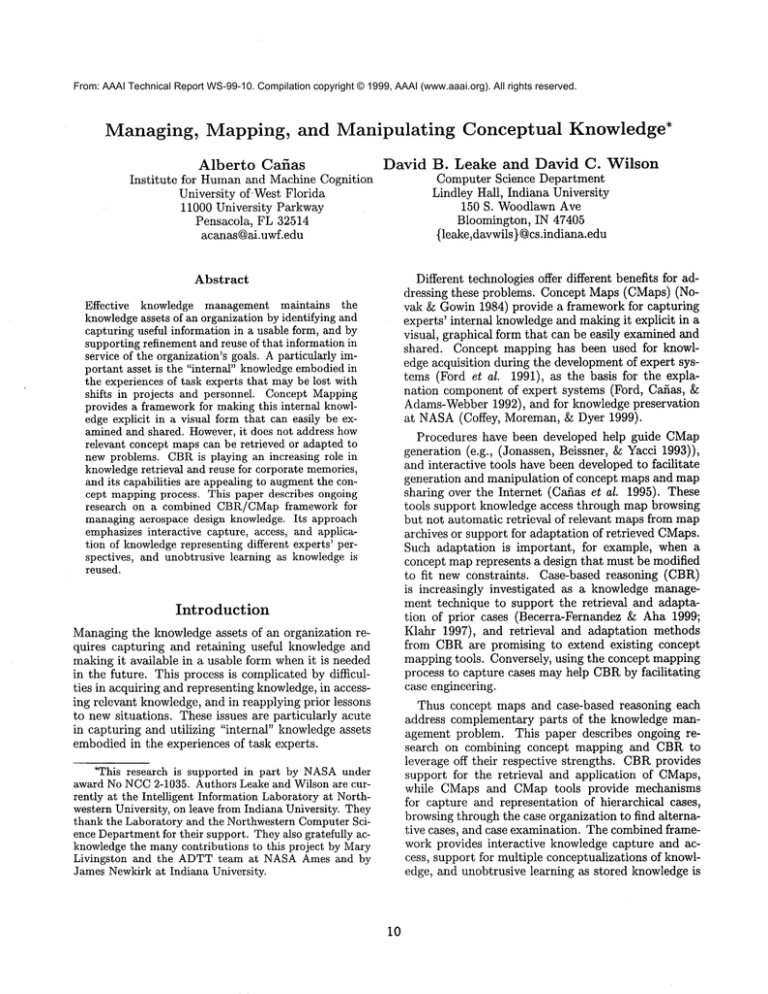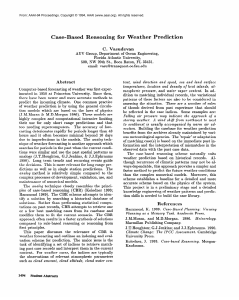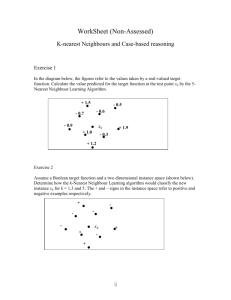
From: AAAI Technical Report WS-99-10. Compilation copyright © 1999, AAAI (www.aaai.org). All rights reserved.
Managing,
Institute
Mapping, and Manipulating
Alberto
Cafias
for Humanand Machine Cognition
University of.West Florida
11000 University Parkway
Pensacola, FL 32514
acanas@ai.uwf.edu
David
Conceptual
Knowledge*
B. Leake and David C. Wilson
Computer Science Department
Lindley Hall, Indiana University
150 S. Woodlawn Ave
Bloomington, IN 47405
{leake,davwils ) @cs.indiana.edu
Different technologies offer different benefits for addressing these problems. Concept Maps (CMaps) (Novak& Gowin 1984) provide a framework for capturing
experts’ internal knowledgeand makingit explicit in a
visual, graphical form that can be easily examinedand
shared. Concept mapping has been used for knowledge acquisition during the development of expert systems (Ford et al. 1991), as the basis for the explanation component of expert systems (Ford, Cafias,
Adams-Webber1992), and for knowledge preservation
at NASA(Coffey, Moreman, & Dyer 1999).
Procedures have been developed help guide CMap
generation (e.g., (Jonassen, Beissner, & Yacci 1993)),
and interactive tools have been developed to facilitate
generation and manipulation of concept maps and map
sharing over the Internet (Cafias et al. 1995). These
tools support knowledge access through map browsing
but not automatic retrieval of relevant maps from map
archives or support for adaptation of retrieved CMaps.
Such adaptation is important, for example, when a
concept maprepresents a design that must be modified
to fit new constraints.
Case-based reasoning (CBR)
is increasingly investigated as a knowledge management technique to support the retrieval and adaptation of prior cases (Becerra-Fernandez & Aha 1999;
Klahr 1997), and retrieval and adaptation methods
from CBRare promising to extend existing concept
mapping tools. Conversely, using the concept mapping
process to capture cases may help CBRby facilitating
case engineering.
Abstract
Effective knowledge management maintains the
knowledgeassets of an organization by identifying and
capturing useful information in a usable form, and by
supporting refinement and reuse of that information in
service of the organization’s goals. A particularly important asset is the "internal" knowledgeembodiedin
the experiences of task experts that maybe lost with
shifts in projects and personnel. Concept Mapping
provides a frameworkfor makingthis internal knowledge explicit in a visual form that can easily be examinedand shared. However,it does not address how
relevant concept mapscan be retrieved or adapted to
new problems. CBRis playing an increasing role in
knowledgeretrieval madreuse for corporate memories,
and its capabilities are appealing to augmentthe concept mappingprocess. This paper describes ongoing
research on a combined CBI~/CMapframework for
managingaerospace design knowledge. Its approach
emphasizesinteractive capture, access, and application of knowledgerepresenting different experts’ perspectives, and unobtrusive learning as knowledgeis
reused.
Introduction
Managing the knowledge assets of an organization requires capturing and retaining useful knowledge and
making it available in a usable form when it is needed
in the future. This process is complicated by difficulties in acquiring and representing knowledge,in accessing relevant knowledge, and in reapplying prior lessons
to new situations. These issues are particularly acute
in capturing and utilizing "internal" knowledgeassets
embodied in the experiences of task experts.
Thus concept maps and case-based reasoning each
address complementary parts of the knowledge management problem. This paper describes ongoing research on combining concept mapping and CBRto
leverage off their respective strengths. CBRprovides
support for the retrieval and application of CMaps,
while CMaps and CMap tools provide mechanisms
for capture and representation of hierarchical cases,
browsing through the case organization to find alternative cases, and case examination. The combined framework provides interactive knowledge capture and access, support for multiple conceptualizations of knowledge, and unobtrusive learning as stored knowledge is
*This research is supported in part by NASAunder
award No NCC2-1035. Authors Leake and Wilson are currently at the Intelligent Information Laboratory at Northwestern University, on leave from Indiana University. They
thank the Laboratory and the Northwestern ComputerScience Departmentfor their support. Theyalso gratefully acknowledgethe manycontributions to this project by Mary
Livingston and the ADTTteam at NASAAmes and by
James Newkirkat Indiana University.
10
applied to new situations.
Concept Mapping for Knowledge
Capture and Sharing
Concept maps represent meaningful relationships between concepts in the form of propositions. Propositions are two or more concepts linked by words to form
a semantic unit. In its simplest form, a concept map
would contain just two concepts connected by a linking
word to form a single proposition. For example, "Centaur is a rocket" would represent a simple map forming
a valid proposition about the concepts "Centaur" and
"Rocket." A concept acquires additional meaning as
more propositions include the concept. Thus, that the
Centaur is a rocket, Centaur is powered by a turbopump, Centaur’s role is as an upper stage, and so on, all
expand the meaning of the concept Centaur. In this
sense, concept maps represent meaning in a framework
of embedded propositions. (Semantic nets are a form
of concept map, but concept maps also include less
constrained network representations.)
Different content and structure are contained in concept maps depending on the contexts for which they
are generated. Consequently, maps having similar concepts can vary from one context to another and can be
highly idiosyncratic. The strength of concept mapslies
in their ability to express a particular person’s knowledge about a given topic in a specific context. Concept
maps thus provide an elegant, easily understood representation of an expert’s domain knowledge.
The Institute
for Human and Machine Cognition
at the University of West Florida has developed software tools that extend the use of concept maps beyond
knowledge capture and examination, to serve as the
browsing interface to a corporate memoryof hierarchical concept maps and associated information resources.
For example, the tools are currently being used in
a NASALewis Center project to capture and preserve Senior Engineers’ design expertise knowledge of
launch vehicle systems integration for the Centaur/RL10 rocket system (Coffey, Moreman, & Dyer 1999).
part of this research project, a prototype browsable,
multimedia model of the experts’ domain knowledge
was built, as illustrated in Figure 1. The CMaptools
allow icons to be associated with concepts, providing
links to other concept maps or other explanatory media
(video, text, images, simulations, WWW
pages, etc.),
which may be distributed throughout the Internet.
The tools also support ways in which the knowledge encoded in concept maps can be selectively shared
among a community of users. Concept maps are hierarchical and may link to other maps over the Internet, enabling distributed teams to collectively develop
and access complex maps. In addition, during the construction of concept maps, the tools allow users to designate sentences or propositions selected from CMaps
for "publication" or sharing with other users. These
propositions, or "claims," are stored in a shared server,
composing a "knowledge soup" of assertions from multiple sources. The system extracts from this information the claims that other users chose to share and that
are relevant to the claims the user published, providing information that may aid the user in constructing
his or her own concept maps. The system also provides a process for commentingon or questioning these
shared claims, querying other users about aspects that
the user does not understand. This process facilitates
distributed discussion, refinement and use of concept
maps, and the technology is currently being enhanced
to develop a collaborative knowledgesharing environment for the NASAAstrobiology Institute.
Combining
CBR and CMaps
Weare investigating
the combination of CMapsand
CBRfor knowledge management to support aerospace
design at NASA.Aerospace design is a complex task
area in which "knowledgeloss" as projects are discontinued or engineers retire is a profound problem. Previous efforts have been made at NASAto store and
access textual reports of important lessons using standard commercial CBRtools (Bagg 1997). However,
even when textual design records have been captured
they may be hard to understand and reuse because
different experts conceptualize designs very differently.
This has resulted in a push to capture design knowledge in the form of CMaps.
Our interactive design support framework, DRAMA
(Design Retrieval and Adaptation Mechanisms for
Aerospace), is being developed in cooperation with
the Advanced Design Technologies Testbed project at
NASAAmesResearch Center. The goal is both to develop useful tools for aerospace design and to establish
a general "knowledge-light" (Wilke et al. 1997) framework for interactive case-based design support systems.
Motivations
for combining CBR and CMaps:
The integration of CBRwith interactive CMaptools
provides leverage for both the CBRand CMapsystems. Existing CMaptools provide an interactive
mediumfor representing and examining designs, but
their framework does not provide search facilities to
find relevant stored CMapsor advice on how to navigate hierarchical CMapstructures. Likewise, although
the tools provide capabilities for interactively defining new CMapsand manipulating their structure by
adding, deleting, or substituting components, the tools
provide little support for the decision-making that underlies the adaptation process. Consequently, their
usefulness can be extended by the addition of automatic facilities for retrieving relevant CMaps,automated aids to navigating CMapsand finding relevant
information therein, and by aids to the reuse of existing
CMaps.
Conversely, case-based reasoning can leverage off the
interactive case definition and revision capabilities of
the CMaptools. CMapscan be used as a browsable
structure for indexing cases, either simply, according
Figure 1: Expert’s Domain Knowledge Model of the Centaur/RL-10 rocket system.
to the nodes under which they are placed, or contextually, according to the user’s perspective, reflected by
the path taken to reach them. For example, different design cases indexed under "Boeing 777" might be
appropriate to present to users depending on whether
they reached that node by following links for hydraulic
systems or links for avionics.
Also, CMaptools provide a convenient method for
entering case information in a middle form between
textual descriptions (which are easy to input but hard
to reason about) and rich structured representations
(which are hard to input but support complex reasoning). In our domain, the push to use concept mapping
to understand the design process means that such cases
will be available at low cost as "seed cases" for the CBR
system. In addition, the CMaptools already provide
crucial functions for interactively generating, examining, and navigating the hierarchical structure of these
cases.
Using the CMap/CBR combination
to support knowledge access, reuse, and capture during design: In DRAMA,
CMapsare used to represent
two types of information. First, they represent hierarchies of aircraft and part types. Second, CMapsrepresent specific information about particular designs such
as their components and component relationships.
The system treats the design process as generating
a CMapto describe each new design. Retrieval and
adaptation of relevant prior CMapsis an integral part
of this process. A designer starts the design process
by selecting a similar prior design as a starting point.
The user may select this design either by using a traditional CBRretrieval tool for stored CMaps, or by
interactively navigating through a set of concept maps
providing alternative "views" of aircraft and aircraft
component types, used to organize CMapsfor specific
aircraft. For example, suppose the designer is considering alternatives for increasing the fuel efficiency of a
large airliner. The designer first navigates through the
types of aircraft to select an aircraft, and selects a particular case--represented as a concept map--to adapt
into the new design. The designer may adapt the specific design or mayrequest that it be abstracted into a
fill-in design template.
Adaptation of design CMapsis supported by providing suggestions of relevant prior designs and enabling
the user to browse CMapsto gather information to
support the adaptation process. In our example, to revise the engine to increase fuel efficiency, the designer
selects the engine node of the current aircraft as the
part to adapt. If no CMapis already present for the
componentselected (e.g., the designer wishes to fill in
a sketchy design by specifying its engine), the designer
can use the interactive CMaptools to create a new
CMapfrom scratch, or browse the CMapsfor designs,
import a design, and then adapt as desired. To help
support adaptations--e.g., to find a more fuel-efficient
engine--the designer may initiate a retrieval focused
either on similar components (e.g., CMapsthat show
aircraft using similar engines), or similar contexts for
the current type of component (e.g., CMapsthat show
the engines of similar aircraft). The result of the process is automatically saved as a new CMapfor future
use. Thus each design augments the corporate memory and provides additional starting points for future
knowledge reuse.
12
Significance
of the approach
CMaps as a medium for capture
and representation
of experiences: Structured representations have been extensively studied within CBR.
They provide much power but may require significant "case engineering" effort (Aha & Breslow 1997;
Simoudis, Ford, & Cafias 1992). Workin textual casebased reasoning (Lenz & Ashley 1998) applies CBR
information already stored in textual form, but textual
cases maybe difficult to use. CMaprepresentations are
at a middle point between these alternatives: they include structural information and are intended to concisely represent key concept properties, but may not
use a standardized semantics. This makes them more
difficult to manipulate autonomously than standardized representations but also easier to acquire when
domain experts are called upon to encode their knowledge. DRAMA
alleviates problems of differing representations in two ways. First, when a user draws a map
and is about to fill in a new link or node, it presents
the user with menuof alternatives from previous maps.
The user is not required to use links from this list, but
when appropriate links are on the list this helps build
a set of standard types over time. The second is simply the "retrieve and adapt" process itself: Whennew
designs are generated by adaptation, significant portions of old representations are brought to new tasks,
resulting in representations with similar structure.
Concept mapping as a form of design rationale capture: Manyprojects have applied rule-based
or model-based approaches to design rationale capture, but encoding and updating the needed information can be prohibitively
expensive. Because CMap
design cases already capture an entire design as context, we believe that useful rationale capture can be
achieved with fairly limited additional information: an
annotation about why the designer chose a particular
component, given the implicit context of the previous
components chosen. DRAMA
enables designers to provide this information as a form of "weak explanation"
of the type advocated by Gruber and Russell (1992),
providing just enough information to guide a designer’s
own reasoning process.
CMaps/CBRas interactive
retrieval:
The ability to browse through the CMapindexing structures
provides a convenient way for users to interactively
search for cases. This is in the spirit of conversational case-based reasoning (CCBR) systems, which
guide the retrieval process through an interactive dialogue of questions (Aha & Breslow 1997), but here
the user directly examines and traverses hierarchical
organizational structures.
Conclusion
Concept mapping is useful for knowledge management as a vehicle for externalizing "internal" expert knowledge, to allow that knowledge to be examined, refined, and reused. CBRis useful for knowl-
edge management in providing an easy-to-understand
knowledgerepresentation--records of specific reasoning episodes--and methods for accessing relevant information and building up a corporate memoryof experiences. The synergy of the two technologies provides a promising approach for addressing corporate
"knowledge loss" by supporting the capture and reuse
of expert design experiences, helping to manage and
maintain an important component of organizational
knowledgeassets.
References
Aha, D., and Breslow, L. 1997. Refining conversational case libraries. In Proceedings of the Second
International Conference on Case-Based Reasoning,
267-278. Berlin: Springer Verlag.
Bagg, T. 1997. RECALL:Reusable experience with
case-based reasoning for automating lessons learned.
http://hope.gsfc.nasa.gov/RECALL/homepg/recall.htm.
Becerra-Fernandez, I., and Aha, D. 1999. Case-based
problem solving for knowledge managementsystems.
In Proceedings of the Twelfth Annual Florida Artificial Intelligence Research Symposium. Menlo Park:
AAAI. In press.
Cafias, A.; Ford, K.; Brennan, J.; Reichherzer, T.;
and Hayes, P. 1995. Knowledge construction
and
sharing in quorum. In World Conference on Artificial
Intelligence in Education.
Coffey, J.; Moreman,D.; and Dyer, J. 1999. Institutional memorypreservation at NASALewis Research
Center. In Proceedings of the HBCU/OMU
Research
Conference.
Ford, K.; Cafias, A. J.; Jones, J.; Stahl, H.; Novak,
J.; and Adams-Webber, J. 1991. ICONKAT: an
integrated constructivist knowledgeacquisition tool.
KnowledgeAcquisition 3.
Ford, K. M.; Cafias, A. J.; and Adams-Webber, J.
1992. Participatory
explanation: A new paradigm?
In Proceedings of the Tenth European Conference
on Artificial Intelligence Workshopon Expert Judgement, HumanError, and Intelligent
Systems, 146155.
Gruber, T., and Russell, D. 1992. Generative design
rationale: Beyond the record and replay paradigm.
Knowledge Systems Laboratory KSL 92-59, Computer Science Department, Stanford University.
Jonassen, D.; Beissner, K.; and Yacci, M. 1993.
Explicit methods for conveying structural knowledge
through concept maps. Hillsdale, N J: Erlbanm. chapter 15, 155.
Klahr, P. 1997. Knowledge management on a global
scale. In Gaines, B.; Musen, M.; and Uthurusamy,
R., eds., Proceedings of the 1997 Spring Symposium
on Artificial Intelligence in KnowledgeManagement,
82-85. Stanford, CA: AAAI.
Lenz, M., and Ashley, K., eds. 1998. Proceedings of
the AAAI-98 workshop on textual case-based reasoning. Menlo Park, CA: AAAIPress.
Novak, J., and Gowin, D. 1984. Learning How to
Learn. NewYork: Cambridge University Press.
Simoudis, E.; Ford, K.; and Cafias, A. 1992. Knowledge acquisition in case-based reasoning: "...and then
a miracle happens". In Dankel, D., ed., Proceedings of
the 1992 Florida AI Research Symposium. FLAIRS.
Wilke, W.; Vollrath,
I.; Althoff,
K.-D.; and
Bergmann, R. 1997. A framework for learning adaptation knowedgebased on knowledge light approaches.
In Proceedings of the Fifth German Workshop on
Case-Based Reasoning.
14



